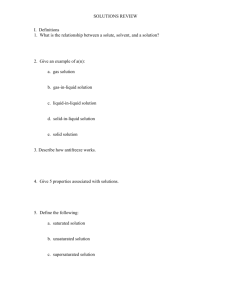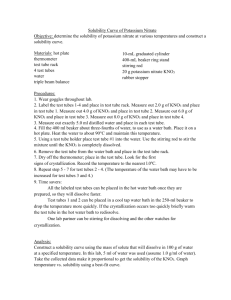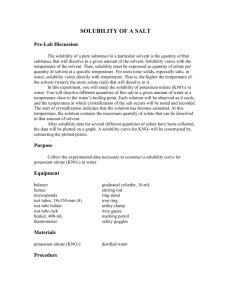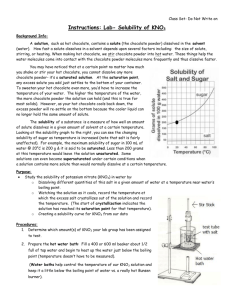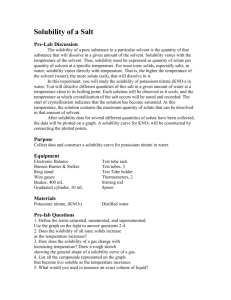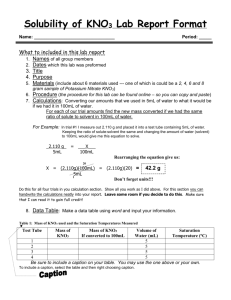Temperature and Solubility -
advertisement
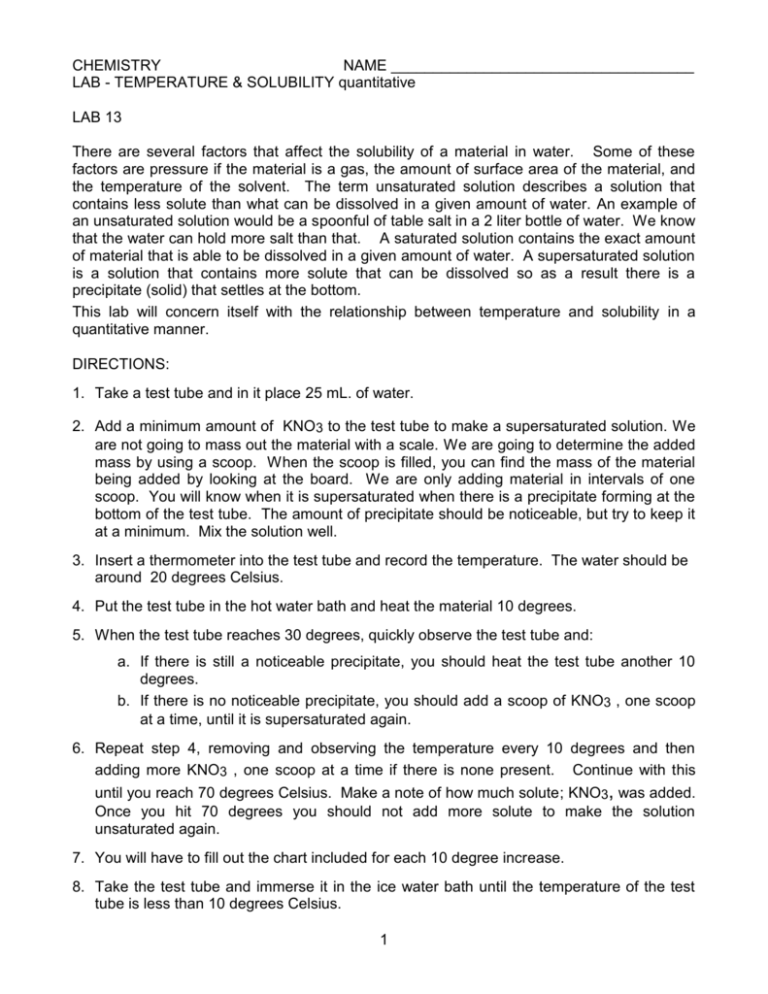
CHEMISTRY NAME ____________________________________ LAB - TEMPERATURE & SOLUBILITY quantitative LAB 13 There are several factors that affect the solubility of a material in water. Some of these factors are pressure if the material is a gas, the amount of surface area of the material, and the temperature of the solvent. The term unsaturated solution describes a solution that contains less solute than what can be dissolved in a given amount of water. An example of an unsaturated solution would be a spoonful of table salt in a 2 liter bottle of water. We know that the water can hold more salt than that. A saturated solution contains the exact amount of material that is able to be dissolved in a given amount of water. A supersaturated solution is a solution that contains more solute that can be dissolved so as a result there is a precipitate (solid) that settles at the bottom. This lab will concern itself with the relationship between temperature and solubility in a quantitative manner. DIRECTIONS: 1. Take a test tube and in it place 25 mL. of water. 2. Add a minimum amount of KNO3 to the test tube to make a supersaturated solution. We are not going to mass out the material with a scale. We are going to determine the added mass by using a scoop. When the scoop is filled, you can find the mass of the material being added by looking at the board. We are only adding material in intervals of one scoop. You will know when it is supersaturated when there is a precipitate forming at the bottom of the test tube. The amount of precipitate should be noticeable, but try to keep it at a minimum. Mix the solution well. 3. Insert a thermometer into the test tube and record the temperature. The water should be around 20 degrees Celsius. 4. Put the test tube in the hot water bath and heat the material 10 degrees. 5. When the test tube reaches 30 degrees, quickly observe the test tube and: a. If there is still a noticeable precipitate, you should heat the test tube another 10 degrees. b. If there is no noticeable precipitate, you should add a scoop of KNO3 , one scoop at a time, until it is supersaturated again. 6. Repeat step 4, removing and observing the temperature every 10 degrees and then adding more KNO3 , one scoop at a time if there is none present. Continue with this until you reach 70 degrees Celsius. Make a note of how much solute; KNO3, was added. Once you hit 70 degrees you should not add more solute to make the solution unsaturated again. 7. You will have to fill out the chart included for each 10 degree increase. 8. Take the test tube and immerse it in the ice water bath until the temperature of the test tube is less than 10 degrees Celsius. 1 9. Record your observations on whether there is any precipitate present in the table below. DATA TABLE # 1 TEMPERATURE in degrees Celsius # of grams OBSERVATION 20 30 40 50 60 70 0 - 10 Answer the following on the space provided. 1. Write out a paragraph describing the changes that the solution went through during the lab. .________________________________________________________________________ .________________________________________________________________________ .________________________________________________________________________ .________________________________________________________________________ 2 2. Create a solubility curve similar to the one in the book for KNO 3. Do this on graph paper and attach it to the lab. 3. Look up the effects on solubility due to surface area. Write about a couple of paragraphs describing how to change the solubility of a material by changing its surface area. .________________________________________________________________________ .________________________________________________________________________ .________________________________________________________________________ .________________________________________________________________________ .________________________________________________________________________ .________________________________________________________________________ .________________________________________________________________________ .________________________________________________________________________ .________________________________________________________________________ .________________________________________________________________________ .________________________________________________________________________ 4. Describe the following terms: solute, solvent, solution, unsaturated solution, saturated solution, supersaturated solution. .________________________________________________________________________ .________________________________________________________________________ .________________________________________________________________________ .________________________________________________________________________ .________________________________________________________________________ .________________________________________________________________________ .________________________________________________________________________ .________________________________________________________________________ .________________________________________________________________________ 3 5. A salt water solution is a solid (salt) dissolved in a liquid (water). Not all solutions are a solid dissolved in a liquid. There are 6 different combinations of solute and solvent. List all 6 and give an example of each. You may need to use reference materials for this question. a________________________________________________________________________ .________________________________________________________________________ b________________________________________________________________________ .________________________________________________________________________ c________________________________________________________________________ .________________________________________________________________________ d________________________________________________________________________ .________________________________________________________________________ e________________________________________________________________________ .________________________________________________________________________ f________________________________________________________________________ .________________________________________________________________________ For this lab you will need to include the following in addition to what has been discussed above: Sources of error Percent error Summary Notes 4



